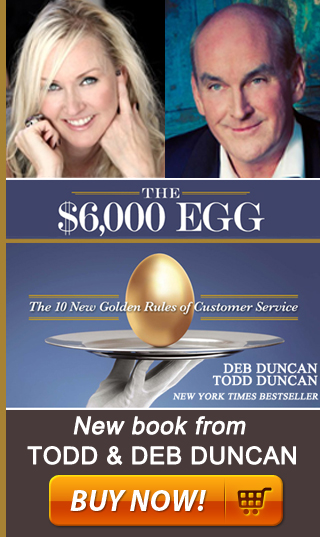Prospecting Is Your Business |
Nov.14 |

By Todd Duncan
My first real memory of selling was when I was in Little League at the age of eight. I remember my dad telling me that if I wanted to sell candy for the team, I had to go where the people were. He also assured me that it was highly unlikely that the doorbell would start ringing if I just sat at home and watched cartoons. Taking my dad’s advice, I did what every budding salesperson would do – I made a list of everyone I knew who would buy candy from me, highlighting those whom I thought would buy the most. Within two days, I was sold out, when everyone else had barely begun. It’s too bad I didn’t remember my young sales experience when I began my first real sales job.
To my recollection, I didn’t have substantial preparation before my first real day in the mortgage industry where I actually had to sell something to make a living. My professional sales preparation was more like, “Here’s your desk. Here’s your phone. Good luck, Todd, you’re on your own.” Maybe that’s why my first day in the field as a professional salesperson was so memorable for the wrong reasons. The bottom line was that I made no sales – after over 100 calls. And since that was not a feeling I was interested in revisiting, I stopped and asked myself why that happened. The answer came at 4 p.m. as I watched one of my competitors make a call. He came through the front door with a look of confidence. He beamed excitement. He professionally announced himself to the receptionist, then was ushered to the office of the prospect on which he was calling.
About 45 minutes later he came out of the office shaking hands with his new client and said, “I look forward to a long and profitable partnership with you.” He had done something that had eluded me all day long. He had secured a new client. After seeing this, I thought, “How could I have that?” The answer, I learned, was that I could have it as soon as I wanted. And the same is true for you. Here’s what I learned in the next several days as I began to purposefully observe other successful salespeople. First, it seemed they made fewer calls than most, but had a much higher conversion rate to sales. And it seemed that the prospects they called on were motivated to meet with them, rather than resistant. Furthermore, it seemed that their appointments generally took a little longer than most but produced more positive results. And finally, it seemed that they were making a lot more money than anyone else. Those observations inspired me greatly, so I started modeling them and my business took off. Like the successful salespeople whom I studied, I just did a few things different to elevate my success: I always tried to identify another client on vendor who knew my prospects’ names so I could use them in my introduction.
This helped build credibility and trust and reduce tension. I never “cold-called” again but made my cold calls warm, my warm calls hot, and my hot calls sizzle by sending a letter in advance of calling for an appointment. I always made sure my initial letters had a Unique Value Proposition – something embedded in the letter that would genuinely pique their attention and captivate their interest. I kept every phone call in which I asked for a business development appointment to less than 90 seconds – whether I called the prospects or they called me. I committed to discovering needs and offering solutions in person rather than on the phone. I sent a thank you letter and a testimonial from an existing client to my prospects two days before meeting with them. This enabled me to thank them ahead of time for agreeing to meet with me. As a result of these changes in approach, my sales began to soar and I became one of the top originators in my company in a matter of months. I think that it is absolutely critical that you prepare for prospecting well, but be aware that there is a point when you have to act. If all you do is take aim, you will never hit the bulls-eye, and worse, you will rarely get any business.
Due to past experiences with an inadequate form of prospecting, you may be a little reticent at first. But you can gain some confidence by learning how to secure the prospects who are most likely to take your business to the next level. There are two types of relationships from which you can draw more prospects without adding hours to your time: centers of influence and existing clients. Centers of influence. These are people who refer quality prospects to you, or are in the position to do so. They aren’t your current clients and aren’t in competition with your current clients. They are able to give you objective advice, and, of course, provide you with potential customers. For a mortgage lender/originator, a center of influence might be a title representative who will refer you to builders or a real estate agent who could pass you additional business. Existing clients. If you are a lender/originator, a client would be a real estate agent with whom you currently partner that refers as many as 20 to 30 people annually who need home loans. Certainly, there is overlap between centers of influence and clients, but you get the general idea. Before you go after a prospecting target, it’s important that you do all you can to increase the probability of landing a long-term, high-trust client. That’s the reason centers of influence are so valuable – because they can save you time and trouble by helping you learn more about your prospects before you try to make them clients.
The key to securing your prospecting sources is to ask this question: Who do I know who knows who I want to know?” Your answer to the question will save you hours of heartache and headache because it will give you your best shot at securing the best clients. And remember that others can sell you better than you can sell yourself. Therefore, prospecting by referral is the most effective and efficient way to obtain solid sales leads – especially in the mortgage industry. By using this method, you will experience less reluctance in your approach to prospects and higher conversion afterward. The key to referral prospecting is implementing something I call a “Referral by Design” process, which begins with a script that you use when calling or writing to your prospect sources. The script starts something like this: “I am expanding the sphere and scope of my business and I need your assistance. Whom do you know who… Will be buying a home in the next six months? Is in need of some financial planning advice? Will be selling a home in the next six months? Is considering refinancing a home? Will be building a custom home in the next year? As you customize these questions for your specific areas of expertise, always remember the idea of social proof. Since other people can sell you better than you can, ask your prospecting sources if you can use their names in the body of your approach letters as well as in your appointment-setting process.
You will find that in many cases, a prospecting source will agree to make a call for you to help set up an appointment. The following are brief summaries of effective methods for obtaining prospect referrals: Point of sale. Never leave a successful business development appointment without seeking referrals. Repurchase cycles. Of course, you also want to ask for future business from the contacts themselves. If you work with clients who have routine buying cycles, always track them. Never leave a successful business development appointment or let existing client relationships exist without determining the next order cycle and/or seeking referrals. Associations and networking groups. Every salesperson should be involved in several associations and networking groups in order to broaden sales and partnership opportunities. If you’re not involved in a group or club, start today. Affinity businesses. Always look for affinity businesses, those that are closely aligned. It is very likely that prospects you are converting to clients have other businesses that their primary business is closely related to.
Here’s a great exercise: Draw a circle in the middle of a sheet of paper and write in that circle your primary client profile. Then in five minutes or less, write every single type of business/prospect that client may be able to refer you to. The first time I did this, it produced 99 additional prospect sources. The entire process that I’ve covered will help you determine with whom you want to do business, so that you can better identify the sources from which you will obtain prospects. You want to do whatever you can to make sure a prospect you are thinking about pursuing has the potential to become the type of client you want for life. If prospects are going to provide you business over an extended period of time, you need to have a good sense that you will work well together.
Your prospect sources can provide a lot of help in this area. I remember contacting one of my centers of influence prior to contacting a prospect. I simply asked her what she knew about my prospect, thinking I would gain some information that would help me better meet this prospect’s needs. “Don’t!” was her reply. “We have worked with her on and off over the last several years and she is a pain. Save yourself the headaches.” My center of influence was as instrumental in telling me who not to do business with as she was in telling me who to do business with. If to the best of your knowledge – and the knowledge of those you trust – your prospects meet your standards, you’re ready to begin approaching your prospects for the purpose of building mutually beneficial relationships with them. And there is not a more solid foundation in the mortgage business than loyal, lucrative relationships.
comments powered by Disqus


 Follow me on Twitter
Follow me on Twitter Like me on Facebook
Like me on Facebook  Connect on LinkedIn
Connect on LinkedIn